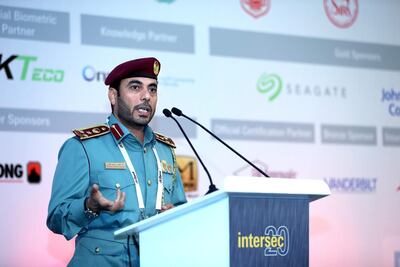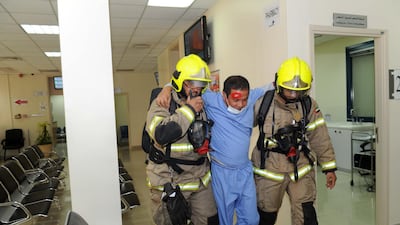Tens of thousands of evacuation drills will be conducted in high rise buildings across the country this year as part of mandatory requirements to get residents to respond quickly, react calmly and follow precautionary procedures in case of a fire.
The drills will help train security staff and help identify the number of children, elderly and people with special needs in towers who require assistance when a fire breaks out, said senior officials on the first day of the Intersec fire conference in Dubai on Sunday.
Dubai has been set a target of about 75,000 evacuation drills this year, up from the 62,000 conducted last year that involved 540,00 tenants.
“The target is not just to get out as fast as possible, we want people to get used to safety procedures. We want them to respond in a calm manner during an evacuation so they don’t panic if it happens,” said Rashid Al Falasi, assistant director general of Fire and Rescue Services at Dubai Civil Defence.

“The most important thing is to train the building’s security staff on how to guide the tenants out of the building safely without any endangering them during the evacuation. They have to keep in mind the number of elderly people, children, pregnant women and children special needs who need help. They also need to be aware of medical conditions people may have like heart conditions.”
Each emirate will have a target number of drills to perform by the end of the year.
“Every emirate will do the same evacuation procedures because this practice will benefit us all. It is as an instruction from the general headquarters,” he said.
At least two drills must be conducted at skyscrapers. They must include an internal drill every six months and one that is inspected by Civil Defence, police, ambulance services and RTA at least once a year.
“The mandatory drills will help them check their own capability, how they respond.” Mr Al Falasi said.
There has been great emphasis on safety following five major tower fires in the country over the past six years which were fuelled by flammable aluminium cladding.
_______________
Read more:
Call for owners, developers to assess fire risk on older UAE buildings
Dubai Civil Defence to eradicate fire threat with nanotechnology
_______________
Calls for stringent inspections were renewed after the second fire in as many years spread across The Torch tower, one of the world’s tallest residential buildings, in Dubai Marina in August last year.
Non-fire rated exterior aluminium panels were scrutinised after a major fire at the Address Downtown hotel on New Year’s Eve in 2016, resulting in the banning of cladding with a thermoplastic core from 2012 in the UAE.
Drones and nanotechnology are now being used to determine the location and spread of a fire before teams reach the area. Technology is being used to create a process to release water vapour in case of short circuits.
On Sunday, officials said they were also working towards standardising response time across the country.
Globally, and in the UAE, emergency response times are between six to eight minutes, as also set by the National Fire Protection Association.
A few years ago Sheikh Mohammed bin Rashid, Vice President and Ruler of Dubai, called for a four- minute response for all emergency calls.
Salem Alhebshi, head of operations planning section of the Abu Dhabi Civil Defence said standardisation was vital.
“Response can be affected by whether the call is in urban, rural or remote areas, size of population and time of day,” he said.
“The maximum time it takes is 8.5 minutes and 4.2 minutes if the location is nearby. We are studying different zones from industrial to residential, identifying, detecting the risk according to population and housing.”
Involving citizens in safety was crucial, said Eric Yap, commission of the Singapore Civil Defence Force.
“Whether responders reach in four or eight minutes, it is already late. But with community education everyone can be prepared. Emergency preparedness is important even for pre-schoolers,” he said.
“If we can’t multiply the number of our responders, we have to best address this by investing heavily in training the population in order to minimise injuries and reduce fatalities.”


